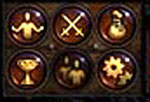Interface
The belt interface in Diablo III is an evolutionary improvement on the versions seen in Diablo I and Diablo II. The form and function will be familiar to players experienced in the other games, but there are a few major changes in Diablo III that make the controls easier to use, but also guide players to operate the game as the D3 Team intends.
Function
The appearance and function of the belt interface are two sides of the same coin. The appearance serves the function, and both mesh with the various skill and play style changes made in Diablo III. The D3 Team is designing Diablo III to be played with 6-8 active skills on each character. There are many more skills than that, but specializing in a half dozen or so with each character build is the route to success. Therefore, rather than throwing in 16 hotkeys, as in Diablo II, there are just half that many in Diablo III, and skills are being designed to be more useful. The team doesn't want characters to be "one-skill wonders" as so many were in Diablo II, where most skills were either overpowered or useless.
The other main goal of the Diablo III interface is to be easier to use and more visual. Hotkeys were easy to use in Diablo II once a player knew how, but to a new user they were not immediately evident. There was no way to see which custom keys were set as hotkeys without opening a different interface, and only the active skills could be seen on the left and right mouse button icons. The D3 Team wants to open up that function, and it appears that they have, from what we can see of the interface in screenshots.
There's some debate about this approach amongst experienced Diablo II players. Some fans are skeptical, wondering if the D3 Team is going too far to make it easy for beginners, and watering down the controls and over-simplifying things in the process. Play testing during the beta test should answer this question.
Appearance
The look of the belt interface is similar to what we saw in Diablo II, with a few changes. Realize that this form is subject to further change during the ongoing development process.
The most recent version of the belt interface was revealed in April 2009.
This screenshot, of a Barbarian's belt interface, shows the key features.
There are 5 hotkey slots, into which skill icons or potions can be dragged. Hitting that button will immediately activate that skill or drink that potion. This is something of a change from Diablo II, where skills were always mapped to the mouse buttons, and could only be activated by clicking the hot key to move them to the mouse click. The 1-5 hotkeys in Diablo III work like the belt slots in Diablo II; for example Identify or Town Portal scrolls could be placed there and cast by clicking the number.
The left click and right click slots are marked by an appropriate little mouse icon. The "Tab" key (and the mouse wheel) switches between two active skills on the right click. Skills are added to these controls by clicking them in the skill tree, and they can then be cast immediately with a left or right click.
Control Icons
The six icons seen to the far right are various game controls, though it's not yet known exactly what function each provides. They're enlarged and brightened in this thumbnail, for easier study.
WWI Interface=
The belt interface was first seen in the WWI gameplay movie, released with the game's announcement in June 2008.
[Image:Belt-interface-wwi1.jpg|center|frame]]
Changes from this to the more recent versions are obvious. There were initially 1-6 hotkeys, along with right and left mouse click buttons. The game option controls for trading, multiplayer options, and more were previously on top, as they were in Diablo II. In more recent versions they've been moved to a small rectangle on the far right.

